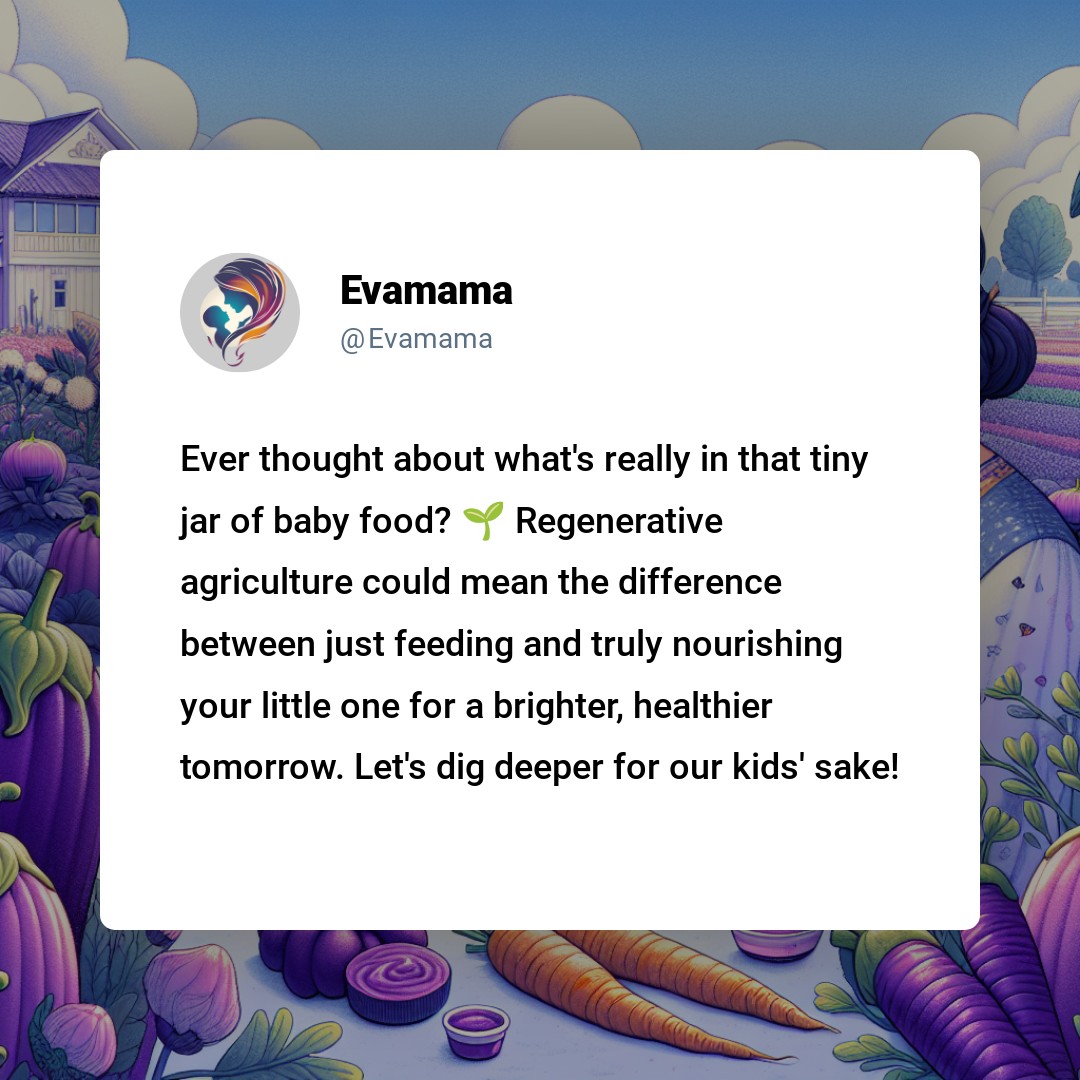Regenerative Agriculture & Baby Food: A Moms Guide to a Healthy Future
Regenerative agriculture is the key to a sustainable future for our children’s nutrition. Imagine opening a jar of baby food and knowing that every spoonful is not only nourishing your little one but also healing the planet. It’s a concern that’s growing among parents who are seeking out the best for their children’s health and the world they will inherit.
This isn’t just about organic labels; it’s about a deeper connection to the earth that sustains us. As a mom and an advocate for sustainable living, I’ve seen firsthand the impact of food choices on both family health and environmental well-being.
Let’s explore how the choices we make today can cultivate a healthier tomorrow for our children. With each bite, we have the power to change the landscape of food production and ensure our kids grow up in a world that’s green, vibrant, and full of life.

Nurturing the Future: Regenerative Agriculture in Baby Food

Imagine a farm where the soil is teeming with life, where plants grow robustly, and where the air is filled with the sounds of buzzing bees and chirping birds. This is the essence of regenerative agriculture, a farming philosophy that could revolutionize the way we produce baby food.
The Soil is Alive: Building Foundations for Healthier Baby Food
Regenerative agriculture is a holistic approach to farming that focuses on nurturing soil health, promoting biodiversity, and restoring ecosystems. It’s a method that goes beyond simply avoiding harmful chemicals; it actively improves the environment. For baby food, this means the ingredients are grown in nutrient-rich soil, which is the starting point for nutrient-dense food that supports your child’s growth and development.
From the Ground Up: How Healthy Soil Makes a Difference
Healthy soil is the bedrock of regenerative agriculture. It’s full of organic matter, teeming with microorganisms that break down this material, releasing nutrients that plants need to grow. These nutrients are then passed on to your baby when they eat regeneratively farmed food, providing them with a level of nourishment that conventional farming methods struggle to match.
Biodiversity: A Symphony of Ecosystem Health
Regenerative farms are alive with a variety of plants, animals, and insects. This biodiversity is not just pleasant to observe; it plays a indispensable role in maintaining a balanced ecosystem. Diverse plant species result in a varied diet for your baby, introducing them to a range of flavors and nutrients. The presence of natural predators helps manage pest populations without the need for harmful pesticides.
Carbon Sequestration: A Breath of Fresh Air for the Planet
One of the most remarkable aspects of regenerative agriculture is its ability to combat climate change through carbon sequestration. By employing practices like cover cropping and no-till farming, regenerative farms capture carbon from the atmosphere and store it in the soil. This not only mitigates the effects of climate change but also leads to the production of baby food with a smaller carbon footprint.
Choosing Regenerative: A Vote for the Planet and Your Baby
When you choose baby food sourced from regenerative farms, you’re making a decision that benefits the planet and your child. You’re supporting farming practices that ensure the land will remain fertile and productive for future generations. It’s a way to provide your child with the best start in life while taking care of the Earth they will inherit.
The Regenerative Ripple Effect: Beyond the Farm
The impact of regenerative agriculture extends beyond the farm. By supporting these practices, you’re part of a movement that encourages more farmers to adopt methods that improve soil health and biodiversity. This collective effort can lead to widespread positive changes in the food industry, And so leading to a healthier planet for all.
Table: The Regenerative Baby Food Advantage
| Aspect of Regenerative Agriculture | Benefit for Baby Food | Impact on Climate Change |
|---|---|---|
| Healthy Soil | Nutrient-Dense Food | Carbon Sequestration |
| Biodiversity | Varied Nutrient Profile | Habitat Restoration |
| Ecosystem Restoration | Purity of Ingredients | Reduction in Greenhouse Gases |
| Carbon Footprint Reduction | Sustainable Choices | Slows Climate Change |
In embracing regenerative agriculture for baby food production, you’re not just feeding your child; you’re nurturing their future in the most profound way possible. It’s a choice that reverberates with every spoonful, every smile, and every step they take towards a healthier, more sustainable world.
Why Does Regenerative Agriculture Matter for Your Child’s Future?

Nourishing the Next Generation: The Health Benefits of Regenerative Baby Food
You want the best for your child, and that includes the food they eat. Regenerative agriculture offers a bounty of health benefits for your little one. By choosing baby food sourced from regenerative farms, you’re providing your child with nourishment that’s free from harmful chemicals. These farms focus on soil health, which leads to the growth of fruits and vegetables rich in nutrients necessary for your child’s development. Imagine your baby’s tiny cells thriving on the purest form of food, laying the foundation for a robust immune system and optimal growth.
A Sustainable Plate: How Regenerative Practices Preserve Our Children’s Future
When you pick up that jar of baby food, you’re not just feeding your child; you’re making a choice about the kind of world they will grow up in. Regenerative agriculture is about more than just food; it’s about water conservation, reducing erosion, and increasing biodiversity. These practices ensure that the planet your child inherits is vibrant and life-sustaining. By supporting regenerative agriculture, you’re voting for a future where water is plentiful, and food security is a given, not a privilege.
The Ripple Effect: Your Baby Food Choices and Global Change
Every purchase you make sends a message. Choosing baby food from regenerative sources tells farmers that you value their efforts to farm ethically and sustainably. It’s a chain reaction: as more parents opt for regenerative products, more farmers will be encouraged to adopt these practices. This shift can lead to widespread environmental benefits, from cleaner air to healthier wildlife habitats. Your choices have the power to transform the agricultural landscape, ensuring a greener tomorrow for your children.
The Ethical Choice: Why Regenerative Agriculture Aligns with Parental Values
As a parent, you’re the first teacher your child will ever have, and your actions speak volumes. By choosing baby food from regenerative sources, you’re instilling values of stewardship and respect for the earth. Regenerative agriculture is not just about growing food; it’s about nurturing the land and the people who work it. It’s a holistic approach that aligns with the ethical considerations many parents hold dear, such as caring for our community and leaving the world better than we found it.
The Table of Transformation: A Closer Look at Regenerative Ingredients
Let’s dive into the specifics. Here’s a table showcasing common baby food ingredients and how regenerative practices enhance their quality:
| Ingredient | Conventional Farming | Regenerative Farming |
|---|---|---|
| Apples | May contain pesticides, lower nutrient density | Grown without synthetic chemicals, higher in antioxidants |
| Carrots | Often grown in depleted soils, less flavor | Richer in flavor, grown in nutrient-rich soil |
| Peas | Higher risk of contamination, less sustainable | Lower carbon footprint, promotes soil health |
This table illustrates the stark differences between conventional and regenerative farming methods. By choosing regenerative, you’re ensuring that your child is getting the best of what the earth has to offer.
The Long View: How Today’s Choices Impact Tomorrow’s World
You’re not just feeding your child; you’re shaping their future. Regenerative agriculture creates a world where your child can breathe cleaner air, drink purer water, and eat food that’s been grown with care for the environment. It’s a legacy of health and sustainability that you can be proud to pass down. Every spoonful of regenerative baby food is a step towards a planet that flourishes for generations to come.






